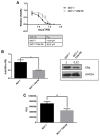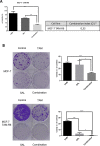Salinomycin co-treatment enhances tamoxifen cytotoxicity in luminal A breast tumor cells by facilitating lysosomal degradation of receptor tyrosine kinases
- PMID: 27409163
- PMCID: PMC5226596
- DOI: 10.18632/oncotarget.10459
Salinomycin co-treatment enhances tamoxifen cytotoxicity in luminal A breast tumor cells by facilitating lysosomal degradation of receptor tyrosine kinases
Abstract
Luminal A breast cancer is the most common breast cancer subtype which is usually treated with selective estrogen receptor modulators (SERMS) like tamoxifen. Nevertheless, one third of estrogen receptor positive breast cancer patients initially do not respond to endocrine therapy and about 40% of luminal A breast tumors recur in five years. In this study, we investigated an alternative treatment approach by combining tamoxifen and salinomycin in luminal A breast cancer cell lines. We have found that salinomycin induces an additional cytotoxic effect by inhibiting the ligand independent activation of ERα. Thereby salinomycin increases the intracellular calcium level. This leads to a premature fusion of endosomes with lysosomes and thus to the degradation of Egfr family members. Since this process is essential for luminal A breast cancer cells to circumvent tamoxifen treatment, the combination of both drugs induces cytotoxicity in tamoxifen sensitive as well as resistant luminal A breast cancer cell lines.
Keywords: breast cancer; endosomal trafficking; resistance; salinomycin; tamoxifen.
Conflict of interest statement
The authors declare no conflict of interest.
Figures










Similar articles
-
MiRNA-27a sensitizes breast cancer cells to treatment with Selective Estrogen Receptor Modulators.Breast. 2019 Feb;43:31-38. doi: 10.1016/j.breast.2018.10.007. Epub 2018 Oct 18. Breast. 2019. PMID: 30415143
-
Acquisition of epithelial-mesenchymal transition phenotype in the tamoxifen-resistant breast cancer cell: a new role for G protein-coupled estrogen receptor in mediating tamoxifen resistance through cancer-associated fibroblast-derived fibronectin and β1-integrin signaling pathway in tumor cells.Breast Cancer Res. 2015 May 21;17(1):69. doi: 10.1186/s13058-015-0579-y. Breast Cancer Res. 2015. PMID: 25990368 Free PMC article.
-
Activity of the antiestrogenic cajanin stilbene acid towards breast cancer.J Nutr Biochem. 2015 Nov;26(11):1273-82. doi: 10.1016/j.jnutbio.2015.06.004. Epub 2015 Jul 22. J Nutr Biochem. 2015. PMID: 26365581
-
The use of selective estrogen receptor modulators and selective estrogen receptor down-regulators in breast cancer.Best Pract Res Clin Endocrinol Metab. 2004 Mar;18(1):47-66. doi: 10.1016/j.beem.2003.08.002. Best Pract Res Clin Endocrinol Metab. 2004. PMID: 14687597 Review.
-
Challenges in the endocrine management of breast cancer.Breast. 2003 Aug;12 Suppl 2:S2-19. doi: 10.1016/s0960-9776(03)80158-3. Breast. 2003. PMID: 14659138 Review.
Cited by
-
A proteomic analysis of chemoresistance development via sequential treatment with doxorubicin reveals novel players in MCF‑7 breast cancer cells.Int J Mol Med. 2018 Oct;42(4):1987-1997. doi: 10.3892/ijmm.2018.3781. Epub 2018 Jul 18. Int J Mol Med. 2018. PMID: 30066829 Free PMC article.
-
Salinomycin as a potent anticancer stem cell agent: State of the art and future directions.Med Res Rev. 2022 May;42(3):1037-1063. doi: 10.1002/med.21870. Epub 2021 Nov 16. Med Res Rev. 2022. PMID: 34786735 Free PMC article. Review.
-
A randomized, placebo-controlled trial of diindolylmethane for breast cancer biomarker modulation in patients taking tamoxifen.Breast Cancer Res Treat. 2017 Aug;165(1):97-107. doi: 10.1007/s10549-017-4292-7. Epub 2017 May 30. Breast Cancer Res Treat. 2017. PMID: 28560655 Free PMC article. Clinical Trial.
-
Salinomycin-Loaded Small-Molecule Nanoprodrugs Enhance Anticancer Activity in Hepatocellular Carcinoma.Int J Nanomedicine. 2020 Sep 15;15:6839-6854. doi: 10.2147/IJN.S236928. eCollection 2020. Int J Nanomedicine. 2020. PMID: 32982236 Free PMC article.
-
Identification of potential target genes of honokiol in overcoming breast cancer resistance to tamoxifen.Front Oncol. 2022 Dec 19;12:1019025. doi: 10.3389/fonc.2022.1019025. eCollection 2022. Front Oncol. 2022. PMID: 36601474 Free PMC article.
References
-
- Society AC. Cancer Facts and Figures 2016. Atlanta: American Cancer Society; 2016.
-
- Society AC. Breast Cancer Facts and Figures 2015-2016. Atlanta: American Cancer Society, Inc; 2015.
-
- Blows FM, Driver KE, Schmidt MK, Broeks A, van Leeuwen FE, Wesseling J, Cheang MC, Gelmon K, Nielsen TO, Blomqvist C, Heikkila P, Heikkinen T, Nevanlinna H, Akslen LA, Begin LR, Foulkes WD, et al. Subtyping of breast cancer by immunohistochemistry to investigate a relationship between subtype and short and long term survival: a collaborative analysis of data for 10,159 cases from 12 studies. PLoS medicine. 2010;7:e1000279. - PMC - PubMed
-
- Eroles P, Bosch A, Perez-Fidalgo JA, Lluch A. Molecular biology in breast cancer: intrinsic subtypes and signaling pathways. Cancer treatment reviews. 2012;38:698–707. - PubMed
-
- Johnston SR, Dowsett M. Aromatase inhibitors for breast cancer: lessons from the laboratory. Nature reviews Cancer. 2003;3:821–831. - PubMed
MeSH terms
Substances
LinkOut - more resources
Full Text Sources
Other Literature Sources
Medical
Research Materials
Miscellaneous

